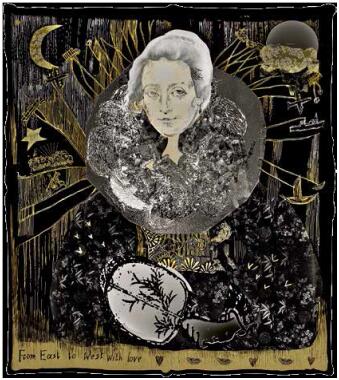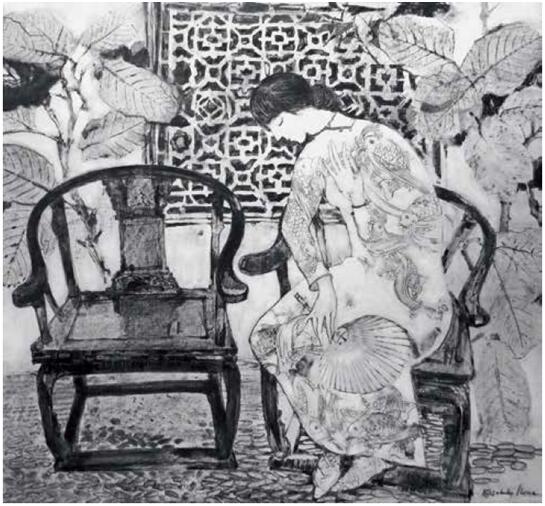
Oikonomidou Florentia(Greece)
Transcultural Time Travelers l / 2016 / printmaking / 134cm×120cm
Works of the 7th Beijing Biennale, 2017
Spread the mainstream national image of China as a great power
With its continuing influence of fixed frequency and cross-border effect, art biennale has become a benchmark of international art since the 20th century. The Beijing Biennale is held in China’s capital, which is also the political and cultural center of China with the geographical advantages and cultural strength that other Chinese cities do not have. The Beijing Biennale is now the only official biennial approved by the State Council.
In recent years, due to the increasing development of China’s economy, the desire of the international community to understand the contemporary Chinese people’s mental and spiritual status is becoming stronger. Art is a good carrier to reflect the image of a nation, but we cannot ignore the fact that the Chinese features displayed at the exhibitions held by Western countries are sometimes one-sided or biased. This reveals the existence of a Western label in the international community that falsely represents China’s reality. It is a very urgent task for us to figure out how to disseminate China’s national image in the form of mainstream art. We need to put China’s mainstream art on an international platform with an international perspective, which truly demonstrates the image of China, and the Biennale is a good carrier.
The application process of the Beijing International Art Biennale started in the spring of 2002, and finally got approved on September 18, 2002, which I think is a very meaningful day in the art history. The State Council approved the 1st Beijing Biennale to be held in 2003, so immediately on that day, we held the first meeting of the curatorial committee. The discussion lasted more than four hours and eventually it was decided that the main exhibits of the 1st Beijing Biennale, themed “Originality: Contemporaneity and Locality”, should be paintings and sculptures. Both of the two conclusions were written into the regulations of the Beijing Biennale to promote our aesthetic values. Now, after 15 years of operation, we can see that we have achieved our desired goals. The National Plan for Cultural Development in the 11th Five-Year Plan Period has included the Beijing Biennale in the list of “Strongly Supported Well-Known Brand of Cultural Activity”, which shows that the Chinese government supports and attaches great importance to the exhibition, and also has established the strategic position of the Beijing Biennale as an internationally renowned brand of contemporary Chinese culture.
Construct a harmonious world and arouse international resonance with academic topics
Art is a universal language, but to be honest, at the preparing stage of the Beijing Biennale, we were particularly concerned that foreign artists might not come. Because of this consideration, we visited almost every embassy and made lots of friends in the diplomatic circles. We launched the Beijing Biennale not only to make a sound in the international art community, but also to contribute to cultural diplomacy. So in the process of contacting and communicating with the embassies, we made them resonate on the principles and theme of the Beijing Biennale, then they would promptly convey the information to their own Ministry of Foreign Affairs and Ministry of Culture, through which the information was further issued to colleges, galleries and groups of art. This process was in fact an effective advertisement of the Beijing Biennale. Therefore, the Beijing Biennale should also be regarded as the grand international publicity of Chinese art. In this period of more than 10 years, our achievements have been remarkable. If there were no international public relations supporting us behind, the number of the participating countries would not be able to increase from 45 to 96. However, the increase in the number of participating countries is not simply a numberical upgrade, it really reflects the fact that the international appeal of Chinese art is becoming stronger and stronger. This shows that the Beijing Biennale has been a successful example of setting up operating standards and promoting independent artistic values in the international art community, and is the most important platform for the extensive dialogue between Chinese art and the world.
From the 1st Beijing Biennale, themed “Originality: Contemporaneity and Locality”, the 2nd, themed “Humanistic Concern of Contemporary Art”, the 3rd, themed “Colors and the Olympics”, the 4th and 5th, themed “Environment Concern and Human Existence” and “Future and Reality” respectively, the 6th, themed “Memory and Dream” to the 7th Beijing Biennale, themed “The Silk Road and World Civilizations”, our first job in the process of visiting the embassies was to explain the theme of the exhibition to them, because they wouldn’t convey the information to their own countries until truly recognized the theme. The theme is our flag. In the planning process, we must first ensure that the coverage of the theme is extensive enough, because we cannot be condescending and force the foreign artists to create something that has nothing to do with themselves since international resonance can only be aroused by global relevance. The last exhibitions have been very successful, embodying the wisdom of collective planning. For example, the Queen of Norway praised the Biennale themed “Colors and the Olympics” after her visiting. The 4th Biennale, themed “Environment Concern and Human Existence”, showed the artistic responsibility of the exhibition, warning the mankind in an artistic way about the crisis facing the earth where we live. The last Biennale, “Memory and Dream” was associated with “Chinese dream”, the current hot topic in China. In the past 15 years, the themes of the Beijing Biennales have been both epochal and international, trying not to restrain the artists while resonating with them. Artists all over the world have answered these themes. From the subjects of artworks created by foreign artists, and even from the titles and descriptions of their works, we can see that they have read our theme carefully. Therefore, the theme of each Biennale has become a good carrier for elucidating our cultural propositions.
The “Pivot in China” for world’s paintings and sculptures
In the world-class international biennales, the Beijing Biennale has maintained an independent stance in its contemporary extension of painting and sculpture, which has achieved initial success for the promotion of return and renaissance of easel painting in the world. The Beijing Biennale not only shows Chinese and foreign works of the five continents, but also pays attention to the guiding of the artistic values, correctly understanding and grasping “other” cultures in the intersection of different cultures, and promoting the solution of international art problems such as “the death of painting” and so on. This is the contribution of Chinese art to the world. The revival of easel painting in the world can help the contemporary art enter the rational and peaceful development track, instead of advocating the aberrance and absurdity of avant-garde art, so as to realize the creative transformation and innovative development of traditional paintings and sculptures.
A Swedish participating artist once said, “China has established a pivot for world art. As a result of the involvement of the Beijing Biennale, the global contemporary art that leans towards the United Sates is becoming more and more balanced.” I think this remark is quite reasonable. There are already more than 100 biennales showing avant-garde art in the world. If the Beijing Biennale does the same, it would certainly be drowned in them. The specialty of Chinese art is the easel art that features painting and sculpture. If we follow the others and feature the avant-garde art, it won’t be significant enough to attract so many people to respond to it.
Now it seems that there are many artists in the world who are engaged in painting and sculpture. We did a survey and found out that about 20%-30% of the artists are engaged in new media art creation, while 70%-80% of the artists are engaged in traditional art creation. Although foreign art galleries or art schools admire new art, artists who really like to engage in traditional art still make up the bulk of it. Some of them were drifting between the traditional and the contemporary, and were excited when they found the Beijing Biennale. So in the past 15 years, the number of the participating countries has grown to more than 100, in fact, which is because the artists feel that they have found the palace of art in their hearts. Many artists have become our voluntary publicists, because they truly approve our platform. For example, an Egyptian artist of the previous Biennale spontaneously put the English brochure of the 7th Beijing Biennale on his Facebook page, which immediately attracted hundreds of followers. Many artists would also invite each other, “Let’s go to the Beijing Biennale. It’s different from other biennales.” This reveals that the world needs the Beijing Biennale, because this exhibition emphasizes the contemporary forms of painting and sculpture, and at the same time is stimulating the contemporary vitality of traditional art.
Respect and preserve cultural diversity
China is one of the sponsors of the UNESCO Universal Declaration on Cultural Diversity. Therefore, it is incumbent upon us to preserve cultural diversity. Since the 1960s, the avant-garde art of the West has dominated the world, and experimental art has completely overwhelmed the traditional easel art. But as early as the 1970s, a French artist sensed the crisis of the avant-garde art that was blindly “seeking novelty and change”. He said, “If art wants to stay alive and energetic, we should abandon this reckless pursuit of novelty because it is easy to become an abuse of ideas and language.” As we can see, some of the excessive performance art has completely broken through the bottom line of human aesthetics. If we do not refute it, then there is no meaning for us to exist. The Beijing Biennale has defended the position of traditional art, and, on this basis, is bringing forth the new so as to protect the diversity of culture.
The launch of the Beijing Biennale also has another significant meaning, that is, to promote the art in Asia, Africa and Latin America.
In the selection of the participating countries, we would never put more weight on Western developed countries. Chinese art would never despise the poor and curry favor with the rich. In fact, there are many outstanding artists in the third world countries, and they have little opportunity to participate in international exhibitions, but China respects them and invites them, so they are very enthusiastic, and that’s why the participating countries of the Beijing Biennale continue to increase in number.
There is one Biennale I remember very clearly. The Beijing Biennale was supposed to be held every two years, but in that year, the Biennale coincided with the National Exhibition of Fine Arts. So it was postponed for one year. At that time, there was an embassy asking, “The Ministry of Culture sent us a letter and said the Beijing Biennale should be held every other year, but nobody contacted us so far. Don’t you want us to participate this time?” After listening to this, I felt particularly pleased because it showed that the exhibition had already attracted the directed attention and such attention was not only from the foreign artists, but also extended to the cultural and diplomatic institutions abroad. This proves that the Beijing Biennale is a good embodiment of cultural diplomacy.
The Venice Biennale is much larger than we are in terms of its whole framework, but the exhibitors are not as many as ours. Because it does not universally respect the contemporary art of all countries. The biggest function of the Beijing Biennale is to establish a platform for the extensive and equal dialogues between Chinese art and the world, which is unique in the world. The Beijing Biennale brings us a lot of contemporary art in countries that are usually less noticed, such as the works of developing countries in Asia, Africa and Latin America.
The 7th Beijing Biennale——Discover the wonders in the exchange of civilizations with art
The 7th Beijing Biennale puts forward its theme as “The Silk Road and World Civilizations”, which is closely linked to China’s “Belt and Road” Initiative and the current status of international cultural exchanges. The Silk Road in a broad sense may have started long ago, and it can be said that the Silk Road is a link between world civilizations. The theme “The Silk Road and World Civilizations”, of course, is also a response to President Xi’s “Belt and Road” appeal, because culture should play the pioneering role in the initiative, and the “connection with people” in the “five connections” cannot do without the promotion of culture and art. During the discussion of this theme, we also considered that there were only more than 60 countries along the Silk Road, but our goal this year was to attract more than 100 participating countries, so the “Silk Road” and the “world civilizations” were juxtaposed lest some countries would be excluded and not come to participate in the exhibition.
The Silk Road is the link of world civilizations. We hope that this exhibition will demonstrate the Silk Road’s great dedication to human civilization, exploring the contribution of Chinese civilization to the world, the influence of other civilizations on China, or the mutual influence of other civilizations. We hope this will be an exhibition of wonders and surprises, offering both immediate and historical meanings.
We hope it would become an exhibition of discovery, creating diverse visual contributions, exploring the relationship between China and foreign countries, and finding that artistic creation could break through restrictions of space and time. So this exhibition is highly anticipated.
We spent a lot of time visiting the embassies. It should be said that the organization of the 7th Beijing Biennale was more taxing than ever, during which I got a lot of useful information. First of all, I never found one diplomat that didn’t know the “Belt and Road”; instead, the understanding was quite thorough. For example, the Cultural Counselor of Indonesian Embassy said, “It was in Indonesia that President Xi proposed the construction of the Maritime Silk Road.” The Cultural Counselor of Romania said, “The theme of this year is better than the previous ones because it better explains how art can promote the common development of human culture in a peaceful way. As early as in the Kangxi period, one of our ancestors in Romania, who served as an envoy of Russia, visited the Qing Dynasty and then returned home and wrote a book. In fact, he was the ‘Marco Polo of Eastern Europe’.” These discoveries
The Syrian ambassador to China also told a touching story. He said, more than a decade ago, he was Syrian ambassador to the United States and loved his own culture deeply. One day, he took the art materials from Syria to a famous gallery in Manhattan, New York, wishing to recommend works of the artists of his country. The gallery owner said, “What’s the art of Syria? I don’t know. It might be difficult to display it here.” He didn’t give him any chance to speak, but the ambassador still put a disc of contemporary Syrian art on the table. Two hours later, he got a call from the owner, asking, “Mr. Ambassador, are you sure that the artworks in the disc are Syrian?” He answered, “Of course.” Then the owner said, “What a surprise! I’ll definitely hold the exhibition.” This Syrian ambassador told us that he would return to Syria two months later to report his work and would gladly advocate the artists to participate in the Beijing Biennale. So I think even diplomats in war-torn countries know how important culture is to build up the international image of a country!
Look into the future——Continue elaborating on China’s artistic proposition to the world for one hundred years
The Silk Road is a microcosm of human culture and civilizational communication, and the Beijing Biennale, as a platform for international cultural exchange, is also dedicated to history and innovation. Historical, authentic and cosmopolitan are the three characteristic dimensions of the Beijing Biennale. Based on the domestic, and taking an international view, it strengthens the unity and leads the value orientation through the selection mechanism. Through exhibition and exchange, it has increased the cohesive force of Chinese and foreign artists. The greater the unity, the greater the effect, it gradually spreads the Chinese spirit and Chinese dream to more places in the world.
The Beijing Biennale project was officially established in 2002, so this year happens to be its 15th anniversary. We spent 15 years focusing on one thing, that is, the academic display of contemporary expression of painting and sculpture around the world, which involves a wide range of radiation with distinctive and targeted academic positioning. At the 15th anniversary, taking “The Silk Road and World Civilizations” as the theme would be a good beginning. Since the Cold War, it has become more and more difficult for the different ethnic groups and religions in the human society to get along with each other. As the contradictions are becoming more and more acute, the human society needs a common understanding. Human beings need to call for peace, cooperation, mutual benefit, reciprocity, communication and exchange through art, which is the artistic proposition the Beijing Biennale is advocating to the whole world.
It is also one of the curatorial principles of the Beijing Biennale to face up to the important current events that happen immediately and to reflect the responsibility and humanistic concern of contemporary art. The oil painting Time-life—Memorial Ceremony for 5.12 Wenchuan by Guang Tingbo and other Chinese artists is the first earthquake themed work collected by the planning team since the breakout of the 5.12 Wenchuan Earthquake during the preparations for the 4th Beijing Biennale. In 2008, the Beijing Olympic Games themed “One World, One Dream” amazed the world. In 2016, Brazil hosted the Rio Olympics and also attracted the attention of the world. In the previous Beijing Biennale exhibitions, there were many works showing the spirit of the Olympic Games and competitive sports. Beijing will host the 2022 Winter Olympics, and we look forward that the Beijing Biennale would be tied with the Olympic Games again.
In the future, the Beijing Biennale will gradually bring all the countries with diplomatic relations with China into the scope of the participating countries, which, of course, requires further effort, including the need for more support from the state finances, as the increase in the participating countries means an increase in funding. The purpose of our visit to the embassies is to persuade the diplomatic agencies of these countries to offer some support to their own participating artists. Ever since the former Egyptian Ambassador’s wife participated in the 1st Beijing Biennale, the Egyptian Ministry of Foreign Affairs has been continuously providing international tickets for its artists from the 1st to the 6th Beijing Biennale. Many Latin American and African artists have also been offered airline tickets by their governments. It is a long-term goal for us to gradually bring in all the countries that have diplomatic relations with China, and for this reason, we need to further expand the international publicity.
While insisting on painting and sculpture as the main exhibits, we should further give exhibition space to other forms of art, such as installation—the extension of sculpture, video image and other new media arts. Because the contemporary transformation of international art is an irresistible trend, we must adapt to it. As long as it is consistent with our aesthetics and, to some extent, brings new stimulation to painting and sculpture, we should properly embrace it. This will help to bring new vitality to the traditional art.
We should also further strengthen the International Symposium on the Beijing Biennale, which is an excellent platform for us to exercise the right to speak and receive various feedbacks. For example, a British artist said, “When traditional cultural frameworks are faced with deconstruction or reorganization, cultural exchanges are of vital importance.” An artist from Austria said, “I would like to thank the Organizing Committee of the Beijing Biennale and hope that the Beijing Biennale and its symposium will keep going on.” In addition, a Greek artist said that he enjoyed the Biennale seminar because he received many artistic ideas, which would help his artistic creation in the future. An artist from Ecuador said, “Beijing has become my second art hometown.” We must live up to their expectations.
As an institutional exhibition, victory only comes from persistence. The Venice Biennale has lasted for more than 100 years, so its voice and the right to choose are unparalleled in the world of art. Once shot out, there is no coming back. If Chinese art wants to expand its influence in the world, it is necessary to continue the Beijing Biennale because this is a powerful tool for us to exercise the right to choose and speak in the world of art. The theme of this era is peace and development, and the international society is increasingly becoming a community of shared destiny. We should use advanced cultural ideas to gradually guide the world art. We can see from the last Beijing Biennale that the participants from the United States and France are largest in number. Therefore, we not only have an impact on the thirdworld countries, but also have affected the Western developed countries, and the outlook is very optimistic. As the media once said, as a huge power “engine”, the Beijing Biennale will undoubtedly affect the future of China and the setup of world’s art. The appeal of art will exceed beyond time and space and cross borders and “the world will be in great harmony if we could accept, respect and appreciate each other’s beauty”. The unique influence of the Beijing Biennale will continue to manifest itself in the continuous operation.
Tao Qin
Deputy Secretary of the Party Leadership Group, Counsel and Vice Secretary-General of China Artists Association
Convener of the Curatorial Committee of the Beijing Biennale

Ilona Kosobuko(Belarus)
Remember You / 2016 / oil and graphite on canvas / 120cm×130cm
Works of the 7th Beijing Biennale, 2017

